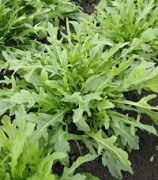The information on this page applies to seedlings sold by LEAF Nursery during our 2021 Seedling Sale.

Diplotaxis tenuiflia. This is an easy-to-grow, aromatic salad green, with slightly more peppery/nutty flavor than the cultivated variety and is rich in nutrients such as Vitamins A, C and K, iron and calcium. Native to the Mediterranean it was a popular salad plant in the Roman times. The deeply lobed leaves provide variety in salads and great flavour to sandwiches and as a garnish. Use the leaves when young and small and re-seed often for continued harvest. This is also a great candidate for container gardens and winter microgreens as it is a cool season crop.[1]
Seed Type
| Organic | Heirloom | Non-GMO | Hybrid | Open-pollinated | Untreated |
Additional Information
| Container Friendly | Trellis Needed | Easy to Grow | Pollinator Friendly |
When to Plant Your Seedling
| Jan | Feb | Mar | Apr | May | Jun | Jul | Aug | Sep | Oct | Nov | Dec |
Growing Conditions
| Light | Temperature | Soil | Water |
|---|---|---|---|
| Full Sun until midsummer and then partial shade | 40 (soil temp) to 75/80 F (ambient temp) | Well drained compost improved soil | regularly |
Planting Tips
| Plant Spacing | Plant Size | Days to Maturity |
|---|---|---|
| 6 inches | 11.8" | 30-40 days from seed |
- Additional instructions: Wild Arugula gets a bit bitter when temperatures reach 80 degrees so plant in spring and fall. Can withstand a light frost. Let them go to flower for the pollinators in the mid-summer. The flowers are tasty too. Wild arugula pesto is an absolute favorite and it is also a great candidate for container gardens and winter microgreens! [1]
- Harvesting instructions: Pick individual leaves from outside of plant (will keep it producing until it starts to flower) when young, 3-6″ long, for best flavour or cut entire plant before flowers form.
Common Problems, Diseases and Pests
- Arugula bolts (goes to flower) most commonly in response to warm or hot weather, uneven soil moisture, wilting, or soil dryness. Overharvesting, rootbinding, and other stressors may also encourage arugula to bolt early. There is nothing that can be done to reverse or stop bolting once it begins; it may be possible to extend harvest slightly by cutting off flower stalks as they appear. It is recommended to tasting leaves for quality and if still reasonable, harvesting the majority of leaves or whole plants at the first sign of bolting, unless you want to save seeds.[3]
- Damping off, mildew
- Flea beetles, aphids, Cabbage Loopers, please see link below for more information. [3]
Useful Resources
- https://bbbseed.com/product/herb-arugula-wild-org/(Seed Source)
- http://mgsantaclara.ucanr.edu/garden-help/vegetables/vegetable-planting-chart/
- https://www.gardenzeus.com/plants/arugula/
- https://sfbaygardening.com/resources/bay-area-planting-calendar/
If you bought this seedling and have any questions or feedback, let us know in the comment section below.